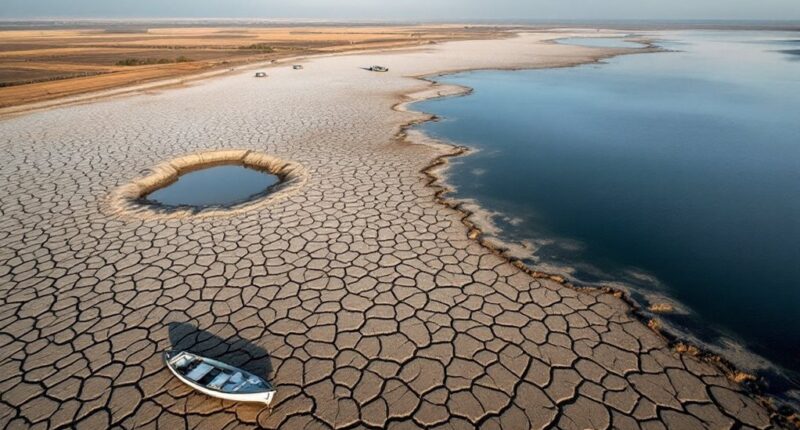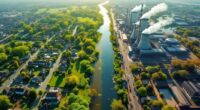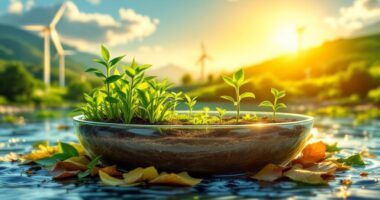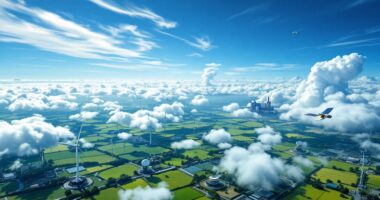The global water crisis affects billions, with 703 million lacking clean water access and 2.2 billion without safe drinking services. Climate change disrupts water cycles, while agriculture gulps 70% of withdrawals. Women spend 250 million hours daily collecting water, hindering economic advancement. Transboundary water governance remains weak, with only six formal agreements among 468 shared aquifers. These challenges demand innovative conservation strategies as water stress threatens 31% of global GDP by 2050. The solutions lie beyond technology alone.

While humanity has made remarkable technological strides in recent decades, the global water crisis looms as perhaps our most pressing environmental challenge. The numbers tell a sobering story: 703 million people lack access to clean water, while a staggering 2.2 billion don’t have safely managed drinking water services. It’s like having the latest smartphone but no way to charge it – all our advances mean little when basic necessities remain out of reach.
Climate change is turning the water cycle into a water rollercoaster – unpredictable, extreme, and occasionally terrifying. Altered rainfall patterns, vanishing glaciers, and rising seas are transforming our hydrological landscape faster than we can adapt. By 2050, about 1.6 billion people will face flood risks, while paradoxically, droughts intensify elsewhere. Mother Nature, it seems, is going through mood swings.
Agriculture gulps down 70% of global water withdrawals – the thirstiest guest at Earth’s water bar. With agricultural water demand projected to increase 19% by 2050, farmers face the equivalent of planning a bigger party with a shrinking beverage budget. Meanwhile, industries pull up a seat to drain another 12% of water resources, with 80% of their wastewater returning to the environment untreated – like borrowing your neighbor’s garden hose and returning it filled with mud. The situation is particularly dire for essential crops like sugarcane and wheat, which are grown in regions experiencing extremely high water stress.
The economic and social impacts ripple outward like a stone dropped in still water. Women and girls spend a collective 250 million hours daily collecting water – time that could be spent on education or economic advancement. Water scarcity could displace 700 million people by 2030, creating a humanitarian challenge of unprecedented scale. Understanding our water footprint is critical to developing effective conservation strategies that address both direct consumption and the hidden water used in producing everyday products.
Management challenges compound the crisis. Only six of 468 transboundary aquifers have formal agreements – imagine sharing an apartment with dozens of roommates but no house rules. The upcoming 10th World Water Forum in Bali presents a critical opportunity for global stakeholders to address these governance gaps. As water stress exposes 31% of global GDP to high risk by 2050, our economic future increasingly depends on how we manage every precious drop of blue gold.
Frequently Asked Questions
How Does Climate Change Impact Water Resources Globally?
Climate change disrupts global water resources through multiple mechanisms. It alters precipitation patterns, intensifies droughts and floods, and accelerates evaporation rates.
Reduced snowpack and earlier snowmelt change traditional water supply timing, while sea-level rise causes saltwater intrusion into coastal freshwater supplies.
Rising temperatures promote harmful algal blooms that contaminate water bodies.
These impacts strain aging infrastructure and exacerbate existing water scarcity issues, particularly threatening the billions already facing water insecurity worldwide.
What Water-Saving Technologies Are Most Effective for Households?
For households, low-flow fixtures deliver impressive water savings with minimal effort.
Smart water management systems, particularly leak detection technology, prevent wasteful drips that can squander 6,000 gallons monthly.
Greywater systems offer substantial conservation by recycling 60% of household water.
Simple behavioral changes like fixing leaks and replacing baths with showers can dramatically reduce consumption.
The combination of smart technology and mindful usage creates the most effective water conservation strategy for today’s homes.
Can Desalination Solve Freshwater Scarcity Problems?
Desalination offers a promising but incomplete solution to freshwater scarcity. While it provides reliable water for coastal regions regardless of rainfall patterns, significant hurdles remain.
The process demands substantial energy, produces environmentally harmful brine waste, and comes with hefty price tags compared to traditional water sources. Think of it as an expensive insurance policy – valuable in crisis-prone areas like the Middle East, but not economically viable everywhere.
It’s one tool in a necessarily diverse water management toolkit.
How Do Agricultural Irrigation Practices Affect Groundwater Levels?
Agricultural irrigation practices greatly impact groundwater levels in complex ways. Intensive irrigation accounts for 70% of global freshwater withdrawals, causing severe depletion in regions like the High Plains and California’s Central Valley.
Inefficient methods like open earthen ditches accelerate depletion, while some practices paradoxically raise water tables, causing soil salinization. Center-pivot systems have transformed grasslands into cultivated pastures.
Sustainable alternatives include drip irrigation, precision agriculture, and managed aquifer recharge systems, which can help restore balance to stressed groundwater resources.
What Policies Have Successfully Reduced Water Consumption in Cities?
Cities worldwide have implemented effective water-saving policies with impressive results.
Tiered pricing structures in San Diego and Cape Town penalize excessive use while funding conservation programs.
Outdoor restrictions, like limited lawn watering schedules and xeriscaping incentives, have dramatically transformed landscapes in Phoenix.
Infrastructure improvements, including leak repairs and smart meters, prevent significant water waste.
Public education campaigns like Melbourne’s “Target 155” have successfully changed consumption behaviors by promoting water-saving practices and water-efficient appliances.









